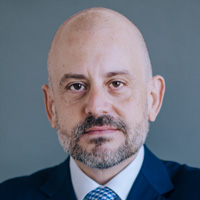How to Get Off the Hamster Wheel of Debt
Yes, you can pay off your debt and start building wealth. It all starts with determining which debts are "bad" and which ones are "good."

We often hear the mantra that debt is bad. Yet that doesn’t stop the majority of people from assuming they will always have bank payments. For many, using credit to purchase vehicles, take vacations or fund home improvement projects is a normal mindset for making their lifestyle work. They believe borrowing money to fill income gaps is the answer to supporting their lifestyle.
In reality, it enters them into a money hamster wheel, which means they work to earn a paycheck and then spend the money they earn to pay bills and make payments to the bank.
This is flawed logic and creates a trap or cycle of continuously relying on banks to fulfill your cash flow needs.

Sign up for Kiplinger’s Free E-Newsletters
Profit and prosper with the best of expert advice on investing, taxes, retirement, personal finance and more - straight to your e-mail.
Profit and prosper with the best of expert advice - straight to your e-mail.
Reset Your Thinking and Reclaim Your Financial Situation
Let’s take a step back and look at the big picture when it comes to money. That big picture is actually relatively simple: Money is either flowing toward you or away from you. If money is flowing toward you, you have control. If money is flowing away from you, you are giving up control.
This is the problem with the typical conversation surrounding debt, the focus often centers solely on paying off the debt. And while getting out of debt is important it cannot be the sole focus.
The focus has to be on the source of the problem not just the symptoms. The source of the problem is poor planning (poor cash flow management and making money decisions in a silo). The symptom is the debt itself.
If we only focus on the symptom (paying the debt off) nothing has been accomplished to fix the problem (poor planning) and is why focusing on the symptom is a lifetime prescription for remaining in the debt cycle.
Therefore, you must first wrest your thinking away from loan terms and how much of a bank payment you can afford and begin to shift toward minimizing the percentage of income you have flowing to banks. By having less money flowing to banks, you have more money flowing into your control that can be used to build wealth for yourself.
So, if you find yourself with cash flowing away from you and into banks, your goal should be to immediately work to restructure or eliminate those payments. Notice I said payments … not the balance.
How to Tell If a Loan Is ‘Bad’
The first step in this process is to identify the loans that require too much of your monthly resources and begin to work toward restructuring them to give control of those dollars back to you to focus on building wealth.
A strategy we use to determine if a loan is in your favor or if it favors the bank is to divide the balance you owe by the minimum monthly payment.
- If that number is lower than 50, then we would consider this a bad loan.
- If the number is between 50 and 100, we would consider this suspect.
- If it is over 100, then we would consider this a good loan.
For example, an auto loan of $30,000 may have a payment of $670 per month. Using our formula, this loan would be assigned a score of 44. This score suggests that the loan is a bad loan and is pulling too much of your monthly income away from you and out of your control.
What should you do about it? One option may be to remove equity from a home to lower the payment to $143 per month and assign it a new score of 209, which suggests this is a good loan. This strategy moves $527 per month away from the bank and back into your control to focus on building wealth.
Next, itemize your current debt balances and minimum payments. Use the formula explained above to identify the loans that need your attention.
Refinancing to Take Control of Debt
Once you have this information written out, the next step is to begin to identify what options are available to you for restructuring the debts determined to be bad loans. That process begins by itemizing all of your resources, such as cash on hand, investments, life insurance cash values and home equity. You will also want to include how much money you are contributing to these each month. This will help you identify how you may be able to tackle your bad loans by focusing your available resources on doing so.
A note on the home equity, if you take the value of your home and multiply that amount by 80% and then subtract your current mortgage amount, you come up with your home’s available equity. If you have a positive number, this is equity you can use to help reduce your payment as described earlier with the refinancing of an auto loan.
Your home: You will likely see that refinancing a home to use home equity is going to be the best-scoring option using our formula. A home mortgage often has more favorable rates and terms that allow you to begin taking back more control of your cash flow. This is not about paying off the home; it is about lowering your bank commitments. Using a 30-year loan is the most favorable loan and results in the lowest possible payment.
Your vehicle: Sometimes refinancing a vehicle can free up money to consolidate other balances and can reduce payments. Again, this is not about the car loan itself; it is about fixing the problem, which begins by looking at your entire financial picture to determine how to best carry the debt you already have to pay off. In this case, an auto loan is a more structured and controllable loan compared to a floating rate credit card that also allows you to charge more onto it.
Your student loans: Renegotiating student loans can work if you stretch the balance out and focus on keeping required payments as low as possible. When it comes to extending terms, many people immediately begin to think about interest charges and extended terms. This is where a utopia collides with reality. If all you have is a student loan and are paying cash for automobiles and other big-ticket items, then this should not be a focus of yours. However, the majority of people who have student loans also have auto loans and credit card debt. All of this is a set of dominoes where a debt payment for something like a student loan can contribute to having limited resources, forcing other bank loans for making ends meet.
Life insurance: A banking strategy using whole life insurance can work in some cases where there is cash on hand enabling us to use the provisions of the policy to consolidate debt and control payments. Cash value life insurance contracts allow for access to loans where the insurance company will use your death benefit and cash surrender value as a collateral. These loans come with very favorable terms, and depending on the design of the policy itself may have uninterrupted growth of your cash values.
When You Have Few Options, Try the Snowball System
Unfortunately, there are circumstances where there is no room for changes. For example, if you are maxed out on credit with little if any resources, there may not be many options available. In this scenario, your best bet is to focus on a debt snowball system, where you pay above the minimum payment on the smallest balances first while paying minimum payments on the other balances. When a debt is paid off you use that payment for paying down the next smallest balance and so on.
Of course, you can take this to another level and begin selling things, downsizing homes and cars and getting a second job, which for some people may be exactly what you need to do.
Your Long-Term Debt Solution
Every situation is different, and you may benefit from using some or all of these strategies. My goal with the information, strategies and techniques discussed here is to help you realize that there needs to be a focus on changing behavior so you no longer use banks to fund your lifestyle.
There are purchases in your past that created the debt that you have and if you dedicate all of your resources to paying those debts off you will find yourself in a continuous cycle of debt. You cannot neglect the fact that you will have future cash needs, and if you are not planning for those now, you will resort to taking more bank loans.
By moving more money into your control and creating a strategic financial plan itemizing all future big ticket needs, you can determine how much of your cash flow should be used to pay down debt and how much should be used to fulfill your future needs.
To get off the hamster wheel of debt requires thinking differently about what purchases you make and how you make them as well as redirecting your focus toward building wealth.
If you focus on building wealth and having access and control of the money you have, you will soon find that you no longer need banks to satisfy your lifestyle.
Securities offered through Kalos Capital Inc., Member FINRA/SIPC/MSRB and investment advisory services offered through Kalos Management Inc., an SEC registered Investment Adviser, both located at11525 Park Wood Circle, Alpharetta, GA 30005. Kalos Capital Inc. and Kalos Management Inc. do not provide tax or legal advice. Skrobonja Financial Group LLC and Skrobonja Insurance Services LLC are not an affiliate or subsidiary of Kalos Capital Inc. or Kalos Management Inc.
Disclaimer
Securities offered only by duly registered individuals through Madison Avenue Securities, LLC. (MAS), Member FINRA & SIPC. Advisory services offered only by duly registered individuals through AE Wealth Management (“AEWM”), a registered investment adviser. Skrobonja Financial Group, LLC, Skrobonja Insurance Services, LLC, AEWM and MAS are not affiliated entities. The article and opinions in this publication are for general information only and are not intended to provide specific advice or recommendations for any individual. We suggest that you consult your accountant, tax or legal adviser with regard to your individual situation.
Get Kiplinger Today newsletter — free
Profit and prosper with the best of Kiplinger's advice on investing, taxes, retirement, personal finance and much more. Delivered daily. Enter your email in the box and click Sign Me Up.

Brian Skrobonja is a Chartered Financial Consultant (ChFC®) and Certified Private Wealth Advisor (CPWA®), as well as an author, blogger, podcaster and speaker. He is the founder and president of a St. Louis, Mo.-based wealth management firm. His goal is to help his audience discover the root of their beliefs about money and challenge them to think differently to reach their goals. Brian is the author of three books, and his Common Sense podcast was named one of the Top 10 podcasts by Forbes. In 2017, 2019, 2020, 2021 and 2022, Brian was awarded Best Wealth Manager. In 2021, he received Best in Business and the Future 50 in 2018 from St. Louis Small Business.